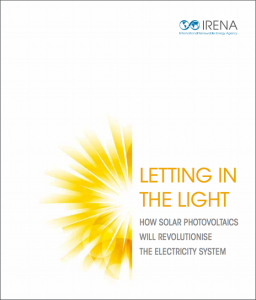Full Title: Letting in the Light: How solar photovoltaics will revolutionise the electricity system
Author(s): Dolf Gielen, Ruud Kempener, Michael Taylor, Francisco Boshell and Amr Seleem (IRENA)
Publisher(s): International Renewable Energy Agency
Publication Date: June 1, 2016
Full Text: Download Resource
Description (excerpt):
Solar photovoltaic (PV) power generation is poised to revolutionise the electrical system in countries around the world. From around 2% in 2016, the share of global electricity generated from solar PV to grow to as much as 13% by 2030, according to this report from the International Renewable Energy Agency (IRENA). The solar industry’s expansion is driven primarily by cost reductions, with the report anticipating further cost declines by up to 59% in ten years.
Letting in the Light examines PV technology, economics, applications, infrastructure and policy, along with their broader impact, highlighting the global PV industry’s prospects for the future.
The report includes data and statistics on:
- Capacity: Solar PV is the most widely owned electricity source in the world in terms of number of installations, and its uptake is accelerating. It accounted for 20% of all new power generation capacity in 2015. In the last five years, global installed capacity has grown from 40 gigawatts (GW) to 227 GW. By comparison, the entire generation capacity of Africa is 175 GW.
- Costs: Solar PV regularly costs just 5 to 10 US cents (USD 0.05-0.10) per kilowatt-hour (kWh) in Europe, China, India, South Africa and the United States. In 2015, record low prices were set in the United Arab Emirates (5.84 cents/kWh), Peru (4.8 cents/kWh) and Mexico (4.8 cents/kWh). In May 2016, a solar PV auction in Dubai attracted a bid of 3 cents/kWh. These record lows underscore the continuing trend of cost reduction.
- Investment: Solar PV now represents more than half of all investment in the renewable energy sector. In 2015, global investment reached USD 67 billion for rooftop solar PV, USD 92 billion for utility-scale systems, and USD 267 million for off-grid applications.
- Jobs: The solar PV value chain today employs 2.8 million people in manufacturing, installation and maintenance, the largest number of any renewable energy.
- Environment: Solar PV generation has already reduced carbon dioxide (CO2) emissions by up to 300 million tonnes per year. This can increase to up to three gigatonnes of CO2 per year in 2030.
Annual PV capacity additions must more more than double in 14 years to attain a 13% share in the electricity mix by 2030.
IRENA puts forward five recommendations to help achieve this increase:
- Updated policies based on the latest innovations;
- Government support of continued research and development activities;
- Creation of a global standards framework;
- Market structure changes;
- Adoption of enabling technologies like smart grids and storage.
